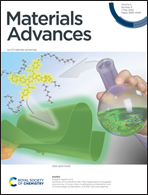Surface-mediated twin polymerisation of 2,2′-spirobi[4H-1,3,2-benzodioxasiline] on multi-walled carbon nanotubes, polyacrylonitrile particles and copper particles†
Abstract
Base-catalysed twin polymerisation (TP) of 2,2′-spirobi[4H-1,3,2-benzodioxasiline] (TM) was used to coat substrate particles with a nanostructured phenolic resin–silica hybrid material layer as proven by solid state NMR and IR spectroscopies. Multi-walled carbon nanotubes (MWCNTs), thermally pre-treated polyacrylonitrile particles (ttPAN), and copper particles are used as solid substrates. The coating process is carried out as seed polymerisation using base-modified substrate particles directly as the catalyst in a slurry of diisopropylnaphtalene (DIPN). For MWCNTs as well as ttPAN the tertiary amine 1,4-diazabicyclo[2.2.2]octane (DABCO) is effective as a polymerisation catalyst, which is adsorbed on the substrates prior to polymerisation. The secondary amine pyrrolidine (Py) is an appropriate polymerisation catalyst for TP when chemisorbed on a copper particle surface as shown by X-ray photoelectron spectroscopy (XPS). According to high-angle annular dark-field single transmission electron microscopy (HAADF-STEM) both quantity and thickness of the phenolic resin–silica hybrid layers between 20 nm and 120 nm on MWCNTs, for example, are controlled by the amount of the monomer used. The phenolic resin–silica layer on the particle surfaces is transformed into a homogenous and nanostructured carbon/silica layer on MWCNTs, N-doped carbon and copper as demonstrated by light microscopy, scanning electron microscopy (SEM), energy dispersive X-ray spectroscopy (EDX), and HAADF-STEM measurements. Removal of the silica component by etching with aqueous hydrofluoric acid (HF) provides microporous carbon layers on the nanotubes and particles with surface areas after Brunauer–Emmett–Teller theory (BET) up to 1150 m2 g−1, which are partly graphitic, as proven by Raman spectroscopy.
![Graphical abstract: Surface-mediated twin polymerisation of 2,2′-spirobi[4H-1,3,2-benzodioxasiline] on multi-walled carbon nanotubes, polyacrylonitrile particles and copper particles](/en/Image/Get?imageInfo.ImageType=GA&imageInfo.ImageIdentifier.ManuscriptID=D2MA00152G&imageInfo.ImageIdentifier.Year=2022)


 Please wait while we load your content...
Please wait while we load your content...